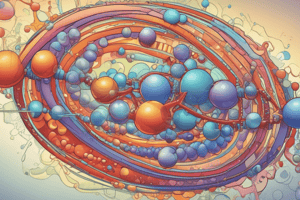Podcast
Questions and Answers
Which molecule is directly broken down to produce ATP during glycolysis?
Which molecule is directly broken down to produce ATP during glycolysis?
- Glucose
- Glycogen
- Insulin
- Glucose-6-phosphate (correct)
What is the primary function of insulin in glycogen metabolism?
What is the primary function of insulin in glycogen metabolism?
- Inhibiting the release of glucose from glycogen
- Activating enzymes for glucose production
- Promoting glycogen synthesis (correct)
- Promoting glycogen breakdown
Which tissue has different outcomes in glycogen metabolism compared to the liver?
Which tissue has different outcomes in glycogen metabolism compared to the liver?
- Muscle cells (correct)
- Kidney cells
- Pancreatic cells
- Adipose tissue
What is the structure of glycogen that allows rapid addition and removal of glucose units?
What is the structure of glycogen that allows rapid addition and removal of glucose units?
Which hormone promotes the breakdown of glycogen?
Which hormone promotes the breakdown of glycogen?
What is the product of glycogen breakdown?
What is the product of glycogen breakdown?
Which molecule is absorbed into the bloodstream after consuming a meal, causing blood sugar to rise?
Which molecule is absorbed into the bloodstream after consuming a meal, causing blood sugar to rise?
What is the role of ATP in regulating glycogen synthesis?
What is the role of ATP in regulating glycogen synthesis?
What is the molecule that signals cells to absorb more glucose and convert it to glucose-6-phosphate?
What is the molecule that signals cells to absorb more glucose and convert it to glucose-6-phosphate?
Flashcards are hidden until you start studying
Study Notes
- Glucose is a six-carbon molecule used to make energy in the form of ATP.
- Glucose is stored in the body as glycogen, a large molecule made up of glucose units linked together.
- Glycogen is compact and capable of rapid addition and removal of glucose units due to its branching structure.
- After consuming a meal, glucose is absorbed into the bloodstream, causing blood sugar to rise.
- The pancreas responds to high blood sugar by secreting insulin, which signals cells to absorb more glucose and convert it to glucose-6-phosphate.
- Glucose-6-phosphate is then broken down during glycolysis, producing ATP as a byproduct.
- Over time, as ATP levels rise, certain enzymes in glycolysis are inhibited, allowing excess glucose-6-phosphate to be used to make glycogen.
- Glycogen synthesis involves the formation of a short linear glycogen chain as a primer, which is then elongated and branched through the addition of more glucose units.
- During fasting or low-energy states, the body breaks down glycogen to release individual glucose units back into the bloodstream for use as energy.
- The breakdown of glycogen involves the cleavage of alpha-1-4 bonds and the transfer of phosphate groups to released glucose units.
- The liver and muscle cells have different enzymes to regulate glycogen metabolism, leading to different outcomes in each tissue.
- Insulin and glucagon are the primary hormones that regulate glycogen metabolism, with insulin promoting synthesis and glucagon promoting breakdown.
Studying That Suits You
Use AI to generate personalized quizzes and flashcards to suit your learning preferences.




